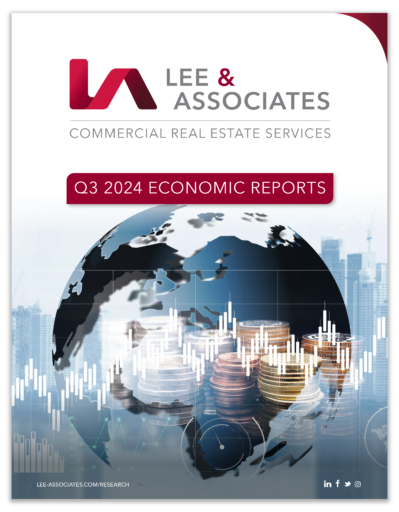GDP GROWTH:
The U.S. economy turned in another solid performance over the summer as healthy consumer and government spending caused the third-quarter gross domestic product to rise at an annual rate of 2.8%, the Commerce Department said.
“All this growth is happening with unemployment holding steady at a low near 4% and inflation moderating to the Fed’s 2% target. It is hard to see the economy performing better,” said Mark Zandi, Chief Economist at Moody’s Analytics.
A group of economists polled just ahead of the government’s GDP estimate believed the growth rate would match the 3% reached in the prior quarter. The small reduction reflected a widening trade deficit as businesses boosted imports to satisfy robust demand and while inventory accumulation was pared back.
Consumer spending, which accounts for more than two-thirds of economic activity, grew at a 3.7% pace. That was the fastest rate since the first quarter of 2023 and was up from the 2.8% pace notched in the second quarter. But the 5.1% drop in residential investment was a drag on growth. It was the second straight quarter that housing market activity fell and at a sharper rate than the 2.8% drop in Q2.
Spending was boosted by outlays on both goods and services, including prescription medication, motor vehicles, doctor visits as well as dining out and hotel and motel stays. Consumption is being supported by a resilient labor market as well as a rise in household net worth, thanks to a stock market boom and higher house prices. Personal income increased $221.3 billion last quarter, down from $315.7 billion in Q2. READ MORE >
EMPLOYMENT:
The U.S. economy added many more jobs than expected in September for the biggest job gain in six months. Nonfarm payrolls surged by 254,000, up from a revised 159,000 in August and greater than the 150,000 Dow Jones consensus forecast. The unemployment rate fell to 4.1%, down 0.1 percentage point.
Along with upward revisions from previous months, the Labor Department’s employment report for September eases concerns about the state of the labor market, which is likely to cause the Fed to be more moderate in any remaining interest rate cuts this year. August’s job total was revised up by 17,000, while July saw a much larger addition of 55,000.
Strength in job creation spilled over to wages, as average hourly earnings increased 0.4% on the month and were up 4% from a year ago. Both figures were ahead of respective estimates.
The report comes amid questions on the labor market’s strength and how it would influence the Fed’s approach to lowering interest rates. Prior to the report, Fed Chairman Jerome Powell characterized the jobs picture as “solid” but said it has “clearly cooled” over the past year.
Following the report experts were upbeat. Jonathan Millar, a senior economist at Barclays told Reuters the Labor Department’s report “reinforces the broad resilience theme for the U.S. economy and pushes aside concerns of an imminent deterioration in labor market conditions,” Millar said. “We maintain our call for a 25-basis point cut in November.” Both the unemployment rate, at 4.1%, and the number of unemployed people, at 6.8 million, changed little in September. These measures are higher than a year earlier, when the jobless rate was 3.8%, and the number of unemployed was 6.3 million. READ MORE >
MONETARY POLICY:
The Federal Reserve in September enacted its first interest rate cut since the early days of the Covid pandemic, trimming half a percentage point off benchmark rates in an effort to head off a labor market slowdown. But labor’s surprising strength in October’s jobs report makes it less likely the Fed will reduce rates more than 25 basis points at either of its remaining meetings this year slated for Nov. 6-7 and Dec. 17-18.
September’s rate cut lowers the federal funds rate to a range between 4.75%-5%. While the rate sets short-term borrowing costs for banks, it affects many consumer products such as mortgages, car loans and credit cards.
Just a few weeks after the rate cut, there was an unexpectedly strong Labor Department report that showed there were 254,000 new hires in September – the most in six months. The Labor Department report also revised job gains in the previous two months by 72,000 added positions.
“The Committee has gained greater confidence that inflation is moving sustainably toward 2%, and judges that the risks to achieving its employment and inflation goals are roughly in balance,” said the Fed Open Market Committee, which sets interest rate policy, in a statement following the meeting.
“We’re trying to achieve a situation where we restore price stability without the kind of painful increase in unemployment that has come sometimes with this inflation. That’s what we’re trying to do, and I think you could take the Committee’s action as a sign of our strong commitment to achieve that goal,” Fed Chair Jerome Powell said at a news conference following the decision. READ MORE >
GLOBAL ECONOMY:
In its latest economic forecast, the International Monetary Fund said that global growth is expected to total an “underwhelming” 3.2% in 2024 and 2025 and said that regional conflicts and protectionist policies remain the greatest threats to trade and commodity markets.
Although much of the IMF’s World Economic Outlook was virtually unchanged from its two previous forecasts, notable revisions have occurred beneath the surface. There were upgrades in the forecast for the United States, offsetting downgrades for other advanced economies to include the largest European countries.
Likewise, in emerging market and developing economies, disruptions to production and shipping of commodities – especially oil – conflicts, civil unrest, and extreme weather events have led to downward revisions to the outlook for the Middle East, Central Asia and sub-Saharan Africa. These have been compensated for by upgrades to the forecast for emerging Asia, where surging demand for semiconductors and electronics, driven by significant investments in artificial intelligence, has bolstered growth. The latest forecast for global growth five years from now, 3.1%, remains mediocre compared with the pre-Covid average. The IMF said that persistent structural headwinds, such as population aging and weak productivity, are holding back potential growth in many economies.
The IMF said that cyclical imbalances have eased since the beginning of the year, leading to a better alignment of economic activity with potential output in major economies. The adjustment is bringing inflation rates across countries closer together and generally has contributed to lower global inflation. Global headline inflation fell from an annual average of 6.7% in 2023 to 5.8% in 2024 and will hit 4.3% in 2025, according to the report, with advanced economies returning to their inflation targets sooner than emerging market and developing economies. As global disinflation continues to progress, the IMF cautioned that bumps on the road to price stability are still possible. Goods prices have stabilized, but price inflation in services remains elevated in many regions. READ MORE >




